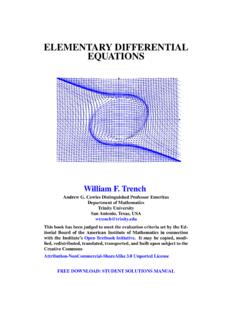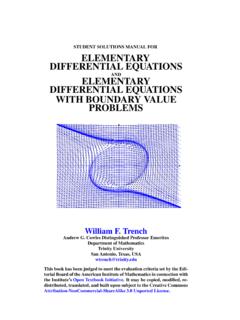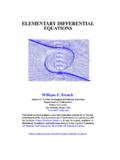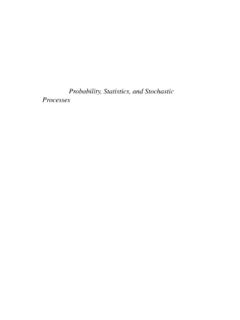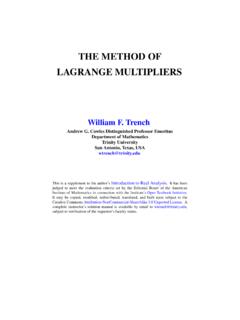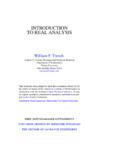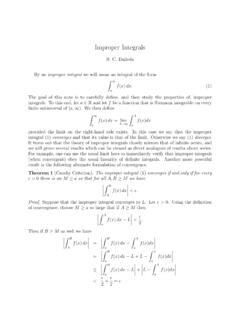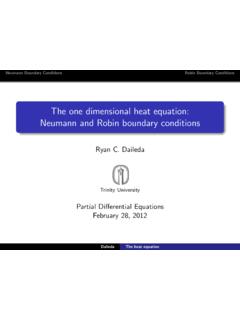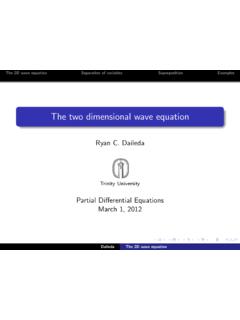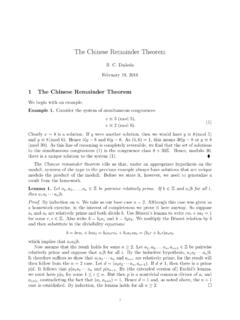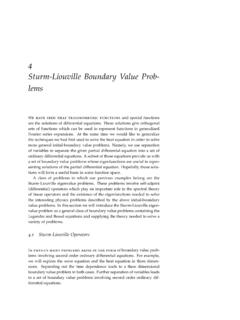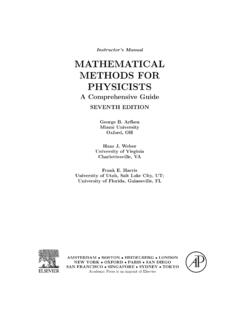Transcription of Introduction to Sturm-Liouville Theory
1 OrthogonalitySturm- liouville problemsEigenvalues and eigenfunctionsIntroduction to Sturm-Liouville TheoryRyan C. DailedaTrinity UniversityPartial Differential EquationsApril 10, 2012 DailedaSturm- liouville TheoryOrthogonalitySturm- liouville problemsEigenvalues and eigenfunctionsInner products with weight functionsSuppose thatw(x) is a nonnegative function on [a,b]. Iff(x) andg(x) are real-valued functions on [a,b] we define theirinnerproduct on[a,b]with respect to the weightwto behf,gi= baf(x)g(x)w(x) sayfandgareorthogonal on[a,b]with respect to theweightwifhf,gi= :The inner product and orthogonality depend on the choice ofa, (x) 1, these definitions reduce to the ordinary TheoryOrthogonalitySturm- liouville problemsEigenvalues and eigenfunctionsExamples1 The functionsfn(x) = sin(nx) (n= 1,2, ..) are pairwiseorthogonal on [0, ] relative to the weight functionw(x) the Bessel function of the first kind of orderm, andlet mndenote itsnth positive zero.
2 Then the functionsfn(x) =Jm( mnx/a) are pairwise orthogonal on [0,a] withrespect to the weight functionw(x) = functionsf0(x) = 1,f1(x) = 2x,f2(x) = 4x2 1,f3(x) = 8x3 4x,f4(x) = 16x4 12x2+ 1,f5(x) = 32x5 32x3+ 6xare pairwise orthogonal on [ 1,1] relative to the weightfunctionw(x) = 1 x2. They are examples ofChebyshevpolynomials of the second TheoryOrthogonalitySturm- liouville problemsEigenvalues and eigenfunctionsSeries expansionsWe have frequently seen the need to express a given function as alinear combination of an orthogonal set of functions. Ourfundamental result generalizes to weighted inner that{f1,f2,f3, ..}is an orthogonal set of functions on[a,b]with respect to the weight function w . If f is a function on[a,b]andf(x) = n=1anfn(x),then the coefficients anare given byan=hf,fnihfn,fni= baf(x)fn(x)w(x)dx baf2n(x)w(x) TheoryOrthogonalitySturm- liouville problemsEigenvalues and eigenfunctionsRemarksThe series expansion above is called ageneralized Fourierseries forf, andanare thegeneralized Fourier is natural to ask:Where do orthogonal sets of functions come from?
3 To what extent is an orthogonal setcomplete, whichfunctionsfhave generalized Fourier series expansions?In the context of PDEs, these questions are answered bySturm- liouville TheoryOrthogonalitySturm- liouville problemsEigenvalues and eigenfunctionsSturm- liouville equationsASturm- liouville equationis a second order linear differentialequation that can be written in the form(p(x)y ) + (q(x) + r(x))y= an equation is said to be inSturm- liouville ,qandrare specific functions, and is a is a parameter, it is frequently replaced by othervariables or familiar ODEs that occur during separation ofvariables can be put in Sturm-Liouville that y + y= 0is a Sturm-Liouville simply takep(x) =r(x) = 1 andq(x) = TheoryOrthogonalitySturm- liouville problemsEigenvalues and eigenfunctionsExamplePut the parametric Bessel equationx2y +xy + ( 2x2 m2)y= 0in Sturm-Liouville we divide byxto getxy +y (xy ) +( 2x m2x)
4 Y= is in Sturm-Liouville form withp(x) =x,q(x) = m2x,r(x) =x,provided we write the parameter as TheoryOrthogonalitySturm- liouville problemsEigenvalues and eigenfunctionsExamplePutLegendre s differential equationy 2x1 x2y + 1 x2y= 0in Sturm-Liouville we multiply by 1 x2to get(1 x2)y 2xy ((1 x2)y ) + y= is in Sturm-Liouville form withp(x) = 1 x2,q(x) = 0,r(x) = 1,provided we write the parameter as .DailedaSturm- liouville TheoryOrthogonalitySturm- liouville problemsEigenvalues and eigenfunctionsExamplePutChebyshev s differential equation(1 x2)y xy +n2y= 0in Sturm-Liouville we divide by 1 x2to get 1 x2y x 1 x2y ( 1 x2y ) +n2 1 x2y= is in Sturm-Liouville form withp(x) = 1 x2,q(x) = 0,r(x) =1 1 x2,provided we write the parameter TheoryOrthogonalitySturm- liouville problemsEigenvalues and eigenfunctionsSturm- liouville problemsASturm- liouville problemconsists ofA Sturm-Liouville equation on an interval.
5 (p(x)y ) + (q(x) + r(x))y= 0,a<x<b,(1)together withBoundary conditions, specified behavior ofyatx=aandx= will assume thatp,p ,qandrare continuous andp>0 on(at least) the open intervala<x< to the general Theory of second order linear ODEs,thisguarantees that solutions to (1) TheoryOrthogonalitySturm- liouville problemsEigenvalues and eigenfunctionsRegularity conditionsAregular Sturm-Liouville problemhas the form(p(x)y ) + (q(x) + r(x))y= 0,a<x<b,c1y(a) +c2y (a) = 0,(2)d1y(b) +d2y (b) = 0,(3)where:(c1,c2)6= (0,0) and (d1,d2)6= (0,0);p,p ,qandrare continuous on [a,b];pandrare positive on [a,b].The boundary conditions (2) and (3) are calledseparatedboundary TheoryOrthogonalitySturm- liouville problemsEigenvalues and eigenfunctionsExampleThe boundary value problemy + y= 0,0<x<L,y(0) =y(L) = 0,is a regular Sturm-Liouville problem (recall that p(x) =r(x) = 1and q(x) = 0).
6 ExampleThe boundary value problem ((x2+ 1)y ) + (x+ )y= 0, 1<x<1,y( 1) =y (1) = 0,is a regular Sturm-Liouville problem (here p(x) =x2+ 1, q(x) =xand r(x) = 1).DailedaSturm- liouville TheoryOrthogonalitySturm- liouville problemsEigenvalues and eigenfunctionsExampleThe boundary value problemx2y +xy + ( 2x2 m2)y= 0,0<x<a,y(a) = 0,isnota regular Sturm-Liouville not?Recall that when put in Sturm-Liouville form we hadp(x) =r(x) =xandq(x) = m2/x. There are several problems:pandrarenot positivewhenx= continuouswhenx= boundary condition atx= 0 is an example of asingular Sturm-Liouville TheoryOrthogonalitySturm- liouville problemsEigenvalues and eigenfunctionsEigenvalues and eigenfunctionsAnonzerofunctionythat solves the Sturm-Liouville problem (p(x)y ) + (q(x) + r(x))y= 0,a<x<b,(plus boundary conditions),is called aneigenfunction, and the corresponding value of iscalled a Sturm-Liouville problem are the valuesof for which nonzero solutions can talk about eigenvalues and eigenfunctions for regularor singular TheoryOrthogonalitySturm- liouville problemsEigenvalues and eigenfunctionsExampleFind the eigenvalues of the regular Sturm-Liouville problemy + y= 0,0<x<L,y(0) =y(L) = 0,This problem first arose when separated variables in the 1-D waveequation.
7 We already know that nonzero solutions occur onlywhen = n=n2 2L2(eigenvalues)andy=yn= sinn xL(eigenfunctions)forn= 1,2,3, ..DailedaSturm- liouville TheoryOrthogonalitySturm- liouville problemsEigenvalues and eigenfunctionsExampleFind the eigenvalues of the regular Sturm-Liouville problemy + y= 0,0<x<L,y(0) = 0,y(L) +y (L) = 0,This problem arose when we separated variables in the 1-D heatequation with Robin conditions. We already know that nonzerosolutions occur only when = n= 2n,where nis thenth positive solution totan L= ,andy=yn= sin( nx)forn= 1,2,3, ..DailedaSturm- liouville TheoryOrthogonalitySturm- liouville problemsEigenvalues and eigenfunctionsExampleIf m 0, find the eigenvalues of the singular sturm -Liouvilleproblemx2y +xy + ( 2x2 m2)y= 0,0<x<a,y(0)is finite,y(a) = problem arose when we separated variables in the vibratingcircular membrane problem .
8 We know that nonzero solutions occuronly when = n= mna,where mnis thenth positive zero of the Bessel functionJm, andy=yn=Jm( nx)forn= 1,2,3, ..(technically, the eigenvalues are 2n= 2mn/a2.)DailedaSturm- liouville TheoryOrthogonalitySturm- liouville problemsEigenvalues and eigenfunctionsThe previous examples demonstrate the following generalproperties of a regular Sturm-Liouville problem (p(x)y ) + (q(x) + r(x))y= 0,a<x<b,c1y(a) +c2y (a) = 0,d1y(b) +d2y (b) = eigenvalues form an increasing sequence of real numbers 1< 2< 3< withlimn n= .Moreover, the eigenfunction yncorresponding to nis unique (upto a scalar multiple), and has exactly n 1zeros in the intervala<x< TheoryOrthogonalitySturm- liouville problemsEigenvalues and eigenfunctionsAnother general property is the that yjand ykare eigenfunctions corresponding todistinct eigenvalues jand k.
9 Then yjand ykare orthogonal on[a,b]with respect to the weight function w(x) =r(x). That ishyj,yki= bayj(x)yk(x)r(x)dx= theorem actually holds for certain non-regularSturm- liouville problems, such as those involving Bessel this result in the examples above we immediatelyrecover familiar orthogonality result explainswhyorthogonality figures so prominentlyin all of our TheoryOrthogonalitySturm- liouville problemsEigenvalues and eigenfunctionsExamplesExampleWrite down the conclusion of the orthogonality theorem fory + y= 0,0<x<L,y(0) =y(L) = the eigenfunctions of this regular Sturm-Liouville problem areyn= sin(n x/L), and sincer(x) = 1, weimmediatelydeduce that L0sin(m xL)sin(n xL)dx= 0form6= TheoryOrthogonalitySturm- liouville problemsEigenvalues and eigenfunctionsExampleIf m 0, write down the conclusion of the orthogonality theoremforx2y +xy + ( 2x2 m2)y= 0,0<x<a,y(0)is finite,y(a)
10 = the eigenfunctions of this regular Sturm-Liouville problem areyn=Jm( mnx/a), and sincer(x) =x, weimmediatelydeducethat a0Jm( mkax)Jm( m ax)x dx= 0fork6= .DailedaSturm- liouville Theory
